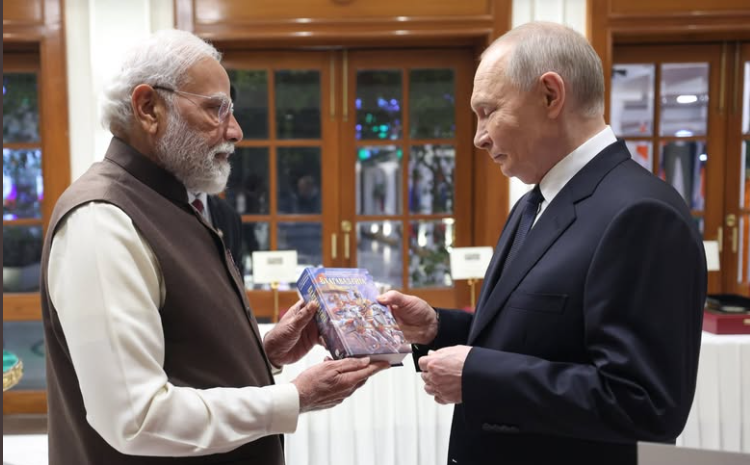How Trump’s Tariffs Awakened India’s Inner Hanuman: A Tale of GST 2.0
- InduQin
- Sep 5
- 3 min read
Updated: Sep 12

When the US under Trump doubled tariffs on Indian goods to 50%, it unintentionally awakened India’s inner Hanuman. Instead of faltering, India launched GST 2.0, a simplified tax reform boosting domestic consumption, which powers 61% of its GDP. The reforms injected ₹5.31 lakh crore into the economy, cushioning the blow from tariffs. With GDP growth at 7.8% and rising consumer confidence, India proved it didn’t need Uncle Sam’s approval. Thanks, America, for the accidental wake-up call!
Once upon a time (around the Trump presidency), the United States decided to play hardball with India by doubling tariffs on Indian goods to a whopping 50%. It seemed like a bold move to flex its economic muscles, but little did they know, they were about to awaken the sleeping giant—much like Hanuman realizing his divine powers.
As Indian exporters worried about job losses and GDP growth, Prime Minister Narendra Modi and his team unveiled a masterstroke: GST 2.0, a domestic reform so well-timed it almost felt like a divine intervention. While Trump was busy building walls (literally and metaphorically), India was busy building resilience.
Thanks, America, for the Wake-Up Call
Finance Minister Nirmala Sitharaman wasted no time clarifying that the GST overhaul wasn’t a knee-jerk reaction to US tariffs. “We didn’t do this because of Trump,” she essentially said (but probably thought, “Thanks for the push, though!”). The reforms, she emphasized, had been in the works for over a year.
And what a reform it was! GST 2.0 simplified the tax regime by consolidating four tax slabs into three: a 5% merit rate, an 18% standard rate, and a 40% slab for sin and luxury goods (because if you can afford a yacht, you can afford to pay up). Not only did this make life easier for businesses, but it also put more money into the hands of everyday Indians.
India’s Economy: Powered by Chapatis, Not Cheeseburgers
Unlike economies that rely on exports (looking at you, Uncle Sam), India’s economic engine runs on domestic consumption. With 61% of GDP driven by private spending, Indians don’t need external validation to keep their economy ticking.
Even with Trump’s tariffs casting a shadow over exports, India’s GDP growth is projected to stay above 6%. Why? Because when you have over a billion people buying groceries, smartphones, and scooters, who really needs America?
And let’s talk about resilience. In the April–June quarter, India’s economy grew by 7.8%, the fastest pace in over a year. Economists noted that while the US tariffs might slow down exports, reforms like GST 2.0 are more than enough to cushion the blow. It’s like India said, “Tariffs? Is that all you got?”
Injecting Billions Into People’s Pockets
Here’s where it gets really fun. The GST overhaul isn’t just a policy; it’s a money cannon aimed at the Indian economy. According to SBI Research, the combined effect of GST and income tax cuts could inject ₹5.31 lakh crore (about $60 billion) into the economy. That’s like giving every Indian household a financial energy drink.
Of this, ₹1.98 lakh crore ($22 billion) comes directly from GST cuts on household goods. The result? More money for families to spend on everything from toothpaste to televisions, effectively neutralizing the impact of American tariffs.
Sure, the government might lose ₹48,000 crore in revenue, but hey, that’s a small price to pay when you’re fueling a consumption-driven economy. Economists predict sectors like automobiles, housing, and FMCG will see a boom, proving that you don’t need exports when you have an army of enthusiastic buyers at home.
Confidence: The Real Currency
While Trump’s America was busy playing trade war chess, India quietly built up its domestic confidence. Inflation is at a manageable 1.55%, unemployment is at 5.2%, and consumer confidence has rebounded to pre-pandemic levels.
The Reserve Bank of India’s Consumer Confidence Index shows that people are ready to spend. Rural families could save 5–6% on monthly expenses, while urban households might see savings of 7–8%. That extra cash is fueling big-ticket purchases like cars, homes, and vacations.
In other words, while the US was busy making things more expensive, India was busy making life more affordable.
The Hanuman Moment
Much like Hanuman realizing he could leap across oceans, India seems to have discovered its economic superpower: domestic consumption. The GST 2.0 reforms have turned the country’s focus inward, proving that self-reliance isn’t just a slogan—it’s a strategy.
As household spending continues to grow (projected at 6.9% in 2025 and 5.5% in 2026), India’s economy remains firmly rooted in its own soil. And while global trade tensions continue to rise, India is busy writing its own success story.
So, thank you, Donald Trump. Your tariffs might have been meant to rattle India, but all they did was awaken a sleeping giant. Hanuman, after all, doesn’t need to cross the ocean twice to prove his strength.







Comments